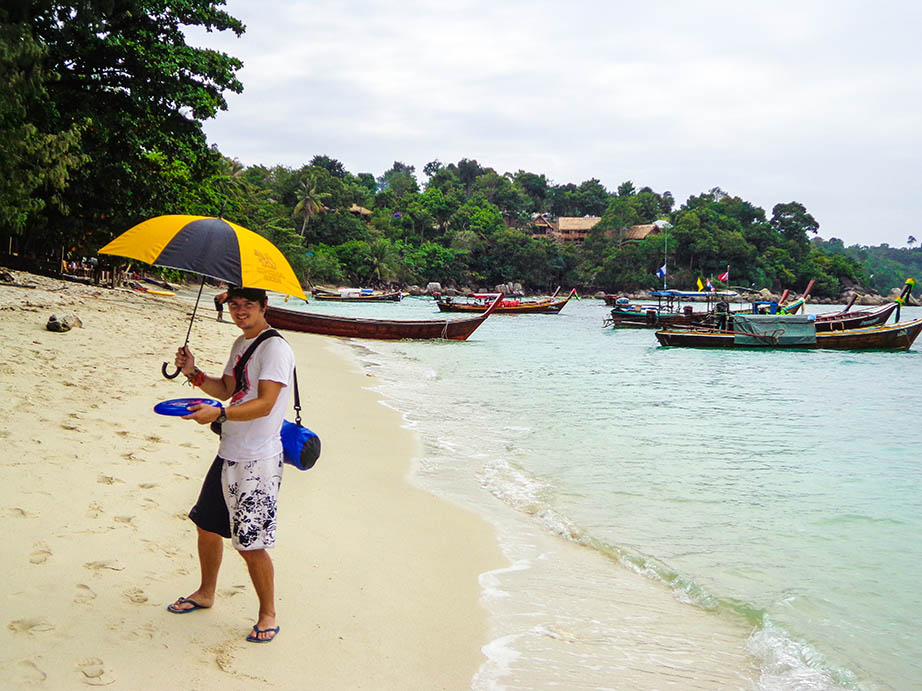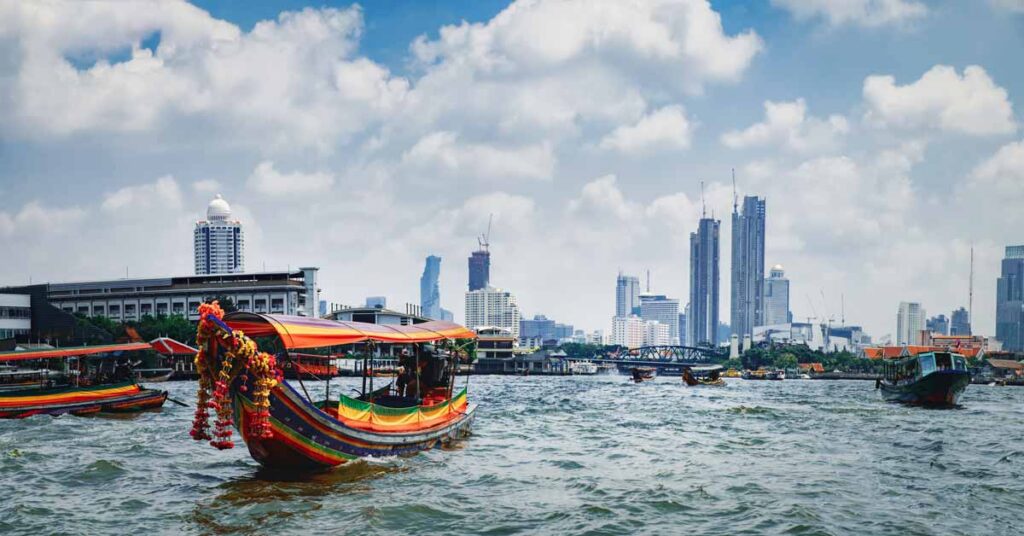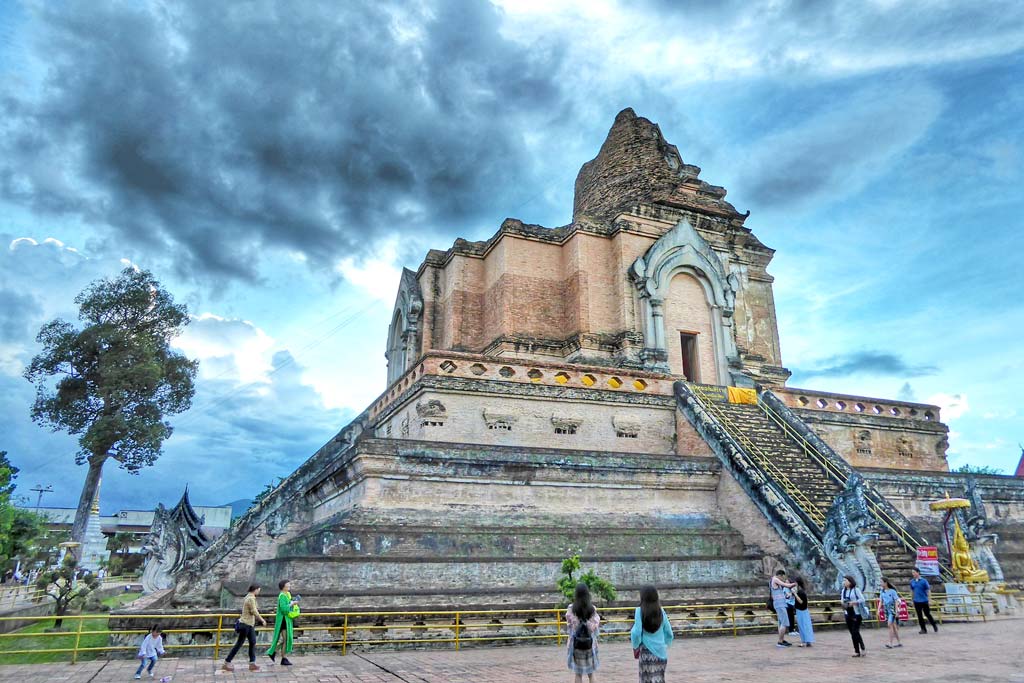Thailand is one of the most beautiful, exciting, and affordable countries to visit, but unfortunately the period when many people have their vacations coincides with the rainy season in Thailand.
When you are dreaming of tropical paradise, sunny blue skies and warm weather any mention of the monsoon season is likely to put a dampener on your ideas of the perfect trip.
But if that’s the only time you can travel to Thailand then it would be shame to let a bit of rain put you off from exploring this amazing country.
Thailand in rainy season is NOT a constant downpour accompanied by cold, dreary skies. It can be a beautiful time to visit Thailand and traveling in the off season can actually have many advantages.
Many of my trips to Thailand have been during the rainy months and as many people ask me ‘is it worth visiting Thailand during the rainy season?‘ I thought it was about time I wrote a blog to let you know what to expect and give you some tips to help you decide if it’s the right time to visit Thailand..

When is the Rainy Season in Thailand?
As part of Southeast Asia, Thailand has a warm and tropical climate. with temperatures generally hovering around 30°C year round, and three seasons – dry, hot and wet.
December – March is the dry season, it’s sunny and relatively cool (by Thai standards) with less humidity and little chance of rain. Unsurprisingly, this is also the peak season for tourism.
April – May is the hot season when the temperatures can climb to over 40°C/100℉.
June – November is the rainy season but it doesn’t rain every day. After the hot season the rains bring relief and cool the country down. The wet season does not mean all day drizzle or constant rains – usually the mornings are fine and sunny with a short (but torrential) shower in the afternoon or evening.
The best weather varies across the country so check the regional climate for the areas you plan to visit. Different areas are affected by Thailand’s two monsoons – the northeast monsoon and the southwest monsoon – so the best time to visit can vary considerably.

Advantages of visiting Thailand in the Rainy Season
The rainy wet season (sometimes called monsoon season) puts off many tourists form visiting Thailand which means that this period is also the low season for tourism – fewer crowds and lower prices.
The atmosphere at the famous tourist attractions, like Bangkok‘s spectacular Grand Palace, is more serene and relaxing in the off season as it’s no so over run with tourists which makes it more enjoyable to visit.
It’s also easier to find transport or accommodation because it’s not all booked up in advance. Many hotels also offer big low season discounts – some places I’ve stayed are half the price of what they are in January so it’s a big saving.
And traveling in the rainy months needn’t stop your sight seeing plans as it rarely rains all day non-stop. Most of the time it’s dry in the mornings with a quick downpour in the afternoon or evening that lasts for an hour.
Use this time to go to a restaurant for lunch, relax with a massage, visit a museum, mall or inside attraction – or just dance in the refreshing rain!
Then, as quickly as the rain came, the sun is back out and it’s dry again in no time. It’s hot and humid in Thailand anyway so often a quick, refreshing downpour of warm rain is a welcome respite.
Another one of the advantages of experiencing Thailand’s wet season ( or green season as it’s also called) is that the nature and landscapes are beautifully lush and green.
Waterfalls gush, flowers bloom and jungles are luscious. Rice fields come alive in a patchwork of colours from bright, emerald green to glowing yellows.
Thailand’s wet season is also the best time to witness farmers working, cultivating rice in the green fields and to see the spectacular, verdant green rice terraces.
Disadvantages of visiting Thailand in the Rainy Season
Of course – there’s a reason it’s called the off season. The weather is unpredictable and heavy rain can disrupt your plans.
The seas can be rough and too dangerous for swimming, sometimes transportation, especially boats and ferries, may have to be cancelled due to weather conditions. Continuous periods of very heavy rain can even cause flooding and thunderstorms can lead to damage and power outages.
It’s a gamble really and that’s why the prices are so much lower. Sometimes you can enjoy plenty of sunny days and enjoy the coolness after the rain, but sometimes you could experience a week of rain and disruption.

Can you visit Thai islands during Rainy Season?
While Thailand’s rainy season can be a great time to explore the cities and jungles, sitting on a beach or being stranded on a tropical island in the rain is not so much fun. Fewer tourists and rougher seas mean that boats to the islands run less frequently in the rainy season too.
What you need to know is that there are two monsoons that affect the southern Thailand islands at opposite times. The southwest monsoon and the northeast monsoon. This means that if the islands on one side are wet the islands on the other side should be dry!
In places like Phuket and Krabi on the west coast in the Andaman sea the southwest monsoon brings rain from May – October, while on the eastern gulf coast of Thailand islands like Koh Samui, Koh Phan Nga and Koh Tao see the most rain from the northeast monsoon between October – February.
Don’t despair, you should be able to find an island where the sun is shining even during the rainy season.

My Experience of Wet Season in Thailand
I’ve experienced Thailand’s rainy season several times in different places – Bangkok and Chiang Mai in northern Thailand, Phuket, Koh Samui and Koh Phan Ngan in southern Thailand, and personally I much preferred traveling in the wet season than in the dry season.
I found April and May were just too hot to do much sightseeing and even laying on the beach or going island hopping got draining really quickly in the heat. I spent a lot of time resting during the midday heat or finding air conditioned cafes to cool down in.
The cool season has the best weather for exploring and outdoor activities. It’s not too hot and rarely wet, but everywhere was much more crowded and prices were higher which lead to a less relaxing time.
I love how the rainy months makes the landscape lush, verdant and green, rather than brown and parched, and sometimes the rain brings a refreshing relief from the heat and humidity.
I’ll be honest, being stuck on a tiny tropical island like Koh Lipe in the rain is not much fun, but in general I’ve always felt like I lucked out with the weather or at least been able to plan indoor and outdoor activities around the rains.
Apart from a couple of days where rain ruined plans it was easy to work around the showers and I enjoyed the lower prices, the less crowded attractions and – a big advantage of traveling in the off season.
I would happily visit again in the off season, but I probably wouldn’t plan a once in a lifetime island hopping trip in September!

My tips for making the most of wet season trips
Plan your day around the rains – The rains usually occur in the afternoon, which allows you to plan your day around them. Do sightseeing in the cool, dry of the morning and then when it is raining it is also a good time to rest, have a nap or do something indoors like visiting a museum or restaurant.
Come prepared for wet weather – Accept that you will get wet from time to time and come prepared with waterproofs. Invest in a waterproof cover for your backpack and make sure you take care of electronics, gadgets or anything that may get ruined in a sudden downpour. An umbrella is used by many locals in South East Asia as a shade from the sun and also protection against the rain.
Bring plenty of mosquito repellent – Rainy season in Thailand also means mosquito season, so take mosquito repellent, anti-itch cream and use a portable mosquito net to reduce the chance of contracting malaria or dengue and irritating bites
Wear lightweight clothing – Wear light, loose clothing to keep you cool in the hot and humid weather between storms and to help you dry off quickly after a downpour. Also wear good soled shoes too as the rains can leave slippery surfaces and often flooded streets.
Be extra careful on the roads – Be careful on the roads – rain can lead to treacherous conditions, flooding or turn dirt roads into mud baths so take extra care, preferably stop and wait out the downpour and then continue with caution. Try not to walk in flood water as it could carry dirt and disease or be hiding uneven surfaces or open holes .
Be flexible and keep up to date with the latest weather – Be careful and pay attention to the news to make sure the area you are heading too is not hit too hard by flooding or cyclones. Be flexible enough to change your plans so you can avoid anywhere where the weather may have taken a dangerous turn.
Allow extra time to get around or travel by boat – If taking local buses allow for your journey to take extra time as the state of the roads deteriorate in heavy rain. The advantage is that river routes will be fuller and boats will operate more frequently.

So is Rainy Season a good time to visit Thaland?
Now that you know more about the rainy wet season and what to expect you can decide if this is a good time to visit Thailand for you.
In my opinion, whether it’s the best time to visit Thailand depends on the length and purpose of your trip.
If you are dreaming of beach days, island hopping, snorkelling and scuba diving – then maybe you should wait and bide your time to visit Thailand in the dry season. Especially if you only have 1 or 2 weeks holiday – it would be a shame if you came on a bad week!
Wet and cloudy weather makes the beaches less appealing and seas can be too rough and dangerous for swimming. It can also cancel ferries and boat trips. Island hopping and beach bumming is better in the dry season.
But if you are visiting Thailand to enjoy everything it has to offer – like the amazing food, the glittering temples, the lush jungle, the interesting historic sights and museums, or even just shopping and spa days, then a bit of rain or cloudy skies shouldn’t ruin your trip.
If you have a longer trip then you also have more chance of getting some beautiful days to enjoy beaches and island hopping. – you’ll also enjoy lower prices and fewer crowds.
So if you are considering visiting Thailand during the wet season then don’t be too put off – it’s possible to work around the weather and still have a great trip and take advantage of lower crowds and prices, just be aware that weather can be unpredictable so it’s a bit of a gamble.
What are your experiences of traveling in Thailand during the rainy season? Would you do it again?
More Thailand Itinerary Inspiration:
My Complete Thailand Travel Guide
The Ultimate Thailand Bucket List
Epic 1 Month Thailand Backpacking Itinerary
Perfect 2 Week Thailand Itinerary: Best of North & South
21 Amazing Places to Visit in Thailand

13 comments
I’m so glad I found this article! I’m heading off in June due to a massive change of plans (I was originally flying out to SE Asia in October). I’m planning to visit Thailand, Vietnam, Cambodia, Malaysia, Indonesia and the Philippines before heading to Australasia. This has definitely wiped away any concerns I had beforehand; the lure of cheaper prices is a winner, too!
Thanks,
Chelsea x
Hi Chelsea
Glad you found the article useful and hope you enjoy your travels in South East Asia – sounds like it will be an epic trip! 🙂
Certainly, a rain or two shouldn’t stop our traveling spirit. 🙂
But here’s a little secret. There are two distinct climate patterns in Southeast Asia. When one part is raining, the other is dry – and vice versa. Thailand, Cambodia, Vietnam, Laos, Myanmar, Philippines are better visited between November-February. But as the rain hits the northern side of Southeast Asia, it’s time to hit the equator. Indonesia, Malaysia, Singapore are all sunshine from April to September!
Hi!!! I loved this post. Thank you fpr being so detailed. We have also a travel blog http://www.vamossomewhere.com @vamossomewhere in social media. But we have mainly traveled America the continent, not only United states. We have not posted yet the rest of the continent, but if it happen to you to visit anywhere from Montreal to Argentina, we will be happy to help you.
I’m so glad I came upon this article. Planning a trip next summer to Thailand/Cambodia/Laos/Vietnam and June and July were the best months in my schedule to go. Was worried I would be wasting my time in the rainy season, but this post has given me the good feelings to push ahead with it.
Hi Ben, glad you liked the post. I like Southeast Asia in rainy season – more green and less tourists! Just don’t forget your umbrella 🙂 Hope you have a good trip
Hi Anna so glad I came across your article going on a cruise in Oct. Beijing. Japan. Taiwan. Hong Kong and Vietnam. This article was posted on our cruise group.thanks for all the tips.
Hi Suraya. Glad my blog helped – however I haven’t travelled in those countries in rainy season – the post is about South East Asia ie Thailand etc. Hope you have a great cruise 🙂
Hey I am planning a 6 month trip from May but I am now a little concerned about the rainy season. Is there a specific route to take during the rainy season to miss the poor weather as much as possible?
Hi Jade, the rains shouldn’t ruin your whole trip. If you want to go to Thailand’s beaches and islands then better to stick to the East coast ( Koh Phangan, Samui, Tao etc) as it shouldn’t be raining there at that time.
There are two monsoons that affect the islands of Thailand and Malaysia at opposite times. This means that if the islands on one side are wet the islands on the other side should be dry. On the west coast the southwest monsoon brings rain from April – October , while on the east coast the rainy season is between September – December.
Hope this helps and hope you have a great trip 🙂
Hi Anna, I am thinking of travelling for 4 to 6 months (August to Dec/Jan) and I am planning on visiting the following places:Malaysia, Thailand, Cambodia and Vietnam (then up to China and Japan). With regards to weather, do you recommend certain places during certain months? Thanks.
Very helpful. I’m a retired Kano (Gringo) living in Subic Bay Philippines and want to use our rainy season (J, J, A) to explore some new places.
SE Thailand, Indonesia and Malaysia sound great. What forecast & recommendations for the Vietnamese coast?
Salamat po
Hi Mike
Glad you found it a useful post – I didn’t go the Vietnamese coast in rainy season (only in dry season) so I can’t really advise you there sorry.
Hope you have a good trip! 🙂